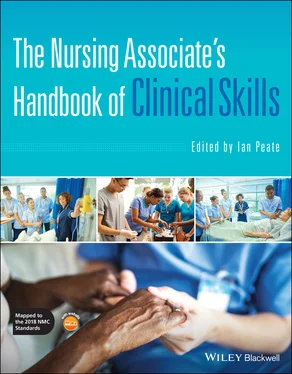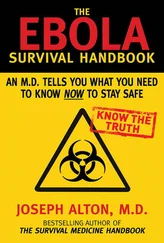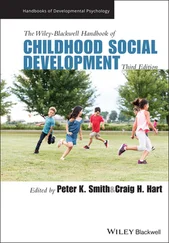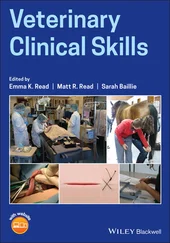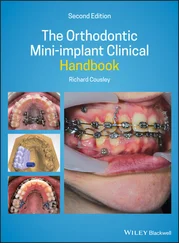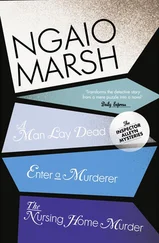The Nursing Associate's Handbook of Clinical Skills
Здесь есть возможность читать онлайн «The Nursing Associate's Handbook of Clinical Skills» — ознакомительный отрывок электронной книги совершенно бесплатно, а после прочтения отрывка купить полную версию. В некоторых случаях можно слушать аудио, скачать через торрент в формате fb2 и присутствует краткое содержание. Жанр: unrecognised, на английском языке. Описание произведения, (предисловие) а так же отзывы посетителей доступны на портале библиотеки ЛибКат.
- Название:The Nursing Associate's Handbook of Clinical Skills
- Автор:
- Жанр:
- Год:неизвестен
- ISBN:нет данных
- Рейтинг книги:4 / 5. Голосов: 1
-
Избранное:Добавить в избранное
- Отзывы:
-
Ваша оценка:
- 80
- 1
- 2
- 3
- 4
- 5
The Nursing Associate's Handbook of Clinical Skills: краткое содержание, описание и аннотация
Предлагаем к чтению аннотацию, описание, краткое содержание или предисловие (зависит от того, что написал сам автор книги «The Nursing Associate's Handbook of Clinical Skills»). Если вы не нашли необходимую информацию о книге — напишите в комментариях, мы постараемся отыскать её.
The Nursing Associate’s Handbook of Clinical Skills
The Nursing Associate’s Handbook of Clinical Skills
The Nursing Associate's Handbook of Clinical Skills — читать онлайн ознакомительный отрывок
Ниже представлен текст книги, разбитый по страницам. Система сохранения места последней прочитанной страницы, позволяет с удобством читать онлайн бесплатно книгу «The Nursing Associate's Handbook of Clinical Skills», без необходимости каждый раз заново искать на чём Вы остановились. Поставьте закладку, и сможете в любой момент перейти на страницу, на которой закончили чтение.
Интервал:
Закладка:
5 Which of these abbreviations could be confused as it could commonly have more than one meaning?DOANHSTPR
Introduction
The saying ‘If it is not written it did not happen’ has been the focus of record‐keeping texts and lectures for many years. This simple statement contains many more complex truths that will be addressed throughout this chapter.
The Nursing and Midwifery Council (NMC) standards of proficiency (2018b) for nursing associates indicate that there are many aspects of communication that must be considered by the nursing associate, and this is explored within this chapter and other chapters of this text. This chapter explores the essential aspects of communication that pertain to the need to communicate both effectively and efficiently through written records and refers to the six platforms found within the Standards of Proficiency (2018b) as well as the NMC Code (2018a). This chapter explores the subject of record‐keeping from both professional and legal viewpoints. A good starting point is to consider the purpose of a written record.
The Nursing and Midwifery Council (2018b) standards of proficiency for nursing associates represent the standards of knowledge and skills that a nursing associate must meet to be registered by the NMC as a safe and effective nursing associate. The following proficiencies apply to this chapter:
1 1.10 write accurate, clear, legible records and documentation
2 1.10 clearly record digital information and data
3 1.11 provide clear verbal, digital or written information and instructions when sharing information, delegating or handing over responsibility for care
4 1.14 demonstrate the ability to keep complete, clear, accurate and timely records
5 3.18 demonstrate the ability to monitor the effectiveness of care in partnership with people, families and carers. Document progress and report outcomes
The NMC updated its Code (Nursing and Midwifery Council 2018a) to ensure that nursing associates were also equally provided for by the NMC with a set of standards to ensure the protection of the public. In this chapter, this publication will be simply referred to as The Code .
The Written Record
A written record could be used for a number of purposes (examples of what may be considered as written records are listed in Box 8.1). Perhaps, the first thing that springs to mind is to record what has happened to a patient during a shift or care episode. This record needs to be of a certain standard which will be discussed later in this chapter. It could be reviewed firstly by colleagues using this as a means of communication to fully understand the events of the day when they are talking to the patient or relatives of the patient. It could be used in the same way by an allied health professional such as an occupational therapist who is treating the patient to have a better understanding of the patient’s abilities and condition before providing treatment and care.
Box 8.1Some Types of Record Used by the Nursing Associate
| Nursing assessment recordsNursing care plansObservation chartsFluid balance chartsRisk assessmentsMedication chartsIncident formsCommunication pages |
Patients can have access to their record by law (this will be discussed later), and this also puts a professional onus onto the nursing associate’s record‐keeping ability. Patients may want to see their records for clarification of the care that they have received or because they feel that there has been negligence; if they lack capacity according to the Mental Capacity Act (2005), they may have an advocate who can read their records so that they are in a better position to assist the multidisciplinary team to make decisions in the patients’ best interest.
Green Flag Legislation
 Mental Capacity Act (2005)
Mental Capacity Act (2005)
This Act was created in 2005 to protect all adults who do not have the capacity to make decisions, either temporarily or more permanently. Capacity is decision specific and can relate to a small decision such as what colour dress to wear or a larger decision such as resuscitation in the event of death. A full description of the Mental Capacity Act (2005) can be found online.
The police may request access to a patient’s notes in certain circumstances, and they may use a court order to do so. The person in charge of the patient’s care is known as the ‘data controller’ and may share the records informally without the order being sought. Certainly, this applies where the access is in the public interest such as when a patient has a communicable disease and the public health department requires the police’s assistance in finding a patient and preventing the transmission of the disease.
Finally, a solicitor or legal professional may request access to records. The records that they may request may be the medical records only, but they may also want to examine nursing records as well. Potentially, therefore, nursing records could be used in court of law.
Touch Point
There are a number of organisations and individuals that can access nursing and medical records. As nursing associates, it is necessary to ensure that all records that are made are in a format that can be followed and understood by others. The remainder of this chapter is dedicated to making record‐keeping clear and compliant with policies and procedures.
Now that it has been established that a variety of people may access records for an equally varied number of reasons, the remainder of this chapter has been divided into two sections. First, the professional requirements from the NMC will be discussed in depth. The second part of this chapter includes a brief discussion on some legislative background to record‐keeping.
Violet Flag
 The records that the nursing associate writes (regardless of format) can be used by other agencies to help them make decisions regarding a person’s needs, for example, the housing department and the local council. The housing department may request to see documentation regarding the patient’s ability to carry out the activities of living (can they walk up a flight of stairs unaided), and the local council may use the data in the nursing associate’s documentation to help determine if the person is entitled to certain benefits. By implementing the following, the nursing associate may be able to avoid issues related to record‐keeping:
The records that the nursing associate writes (regardless of format) can be used by other agencies to help them make decisions regarding a person’s needs, for example, the housing department and the local council. The housing department may request to see documentation regarding the patient’s ability to carry out the activities of living (can they walk up a flight of stairs unaided), and the local council may use the data in the nursing associate’s documentation to help determine if the person is entitled to certain benefits. By implementing the following, the nursing associate may be able to avoid issues related to record‐keeping:
Always use factual, reliable, accurate, objective and unambiguous patient information.
Employ your senses in order to record what you did, for example, ‘I heard’, ‘felt’ and ‘saw’.
Where necessary, use quotation marks when you are recording what has been said to you.
Be sure there is evidence provided for any decision recorded, for example, denying access to a visit from parents.
Notes must be accurately dated, timed and signed, with your name printed alongside the entry, and avoid the use of initials.
Make a note of any objections you may have to the care that has been given.
Do not include jargon, meaningless phrases, such as ‘patient had a good day’, irrelevant speculation and offensive subjective statements.
When writing notes, where this is possible, do so with the involvement and understanding of the patient or carer.
Читать дальшеИнтервал:
Закладка:
Похожие книги на «The Nursing Associate's Handbook of Clinical Skills»
Представляем Вашему вниманию похожие книги на «The Nursing Associate's Handbook of Clinical Skills» списком для выбора. Мы отобрали схожую по названию и смыслу литературу в надежде предоставить читателям больше вариантов отыскать новые, интересные, ещё непрочитанные произведения.
Обсуждение, отзывы о книге «The Nursing Associate's Handbook of Clinical Skills» и просто собственные мнения читателей. Оставьте ваши комментарии, напишите, что Вы думаете о произведении, его смысле или главных героях. Укажите что конкретно понравилось, а что нет, и почему Вы так считаете.
